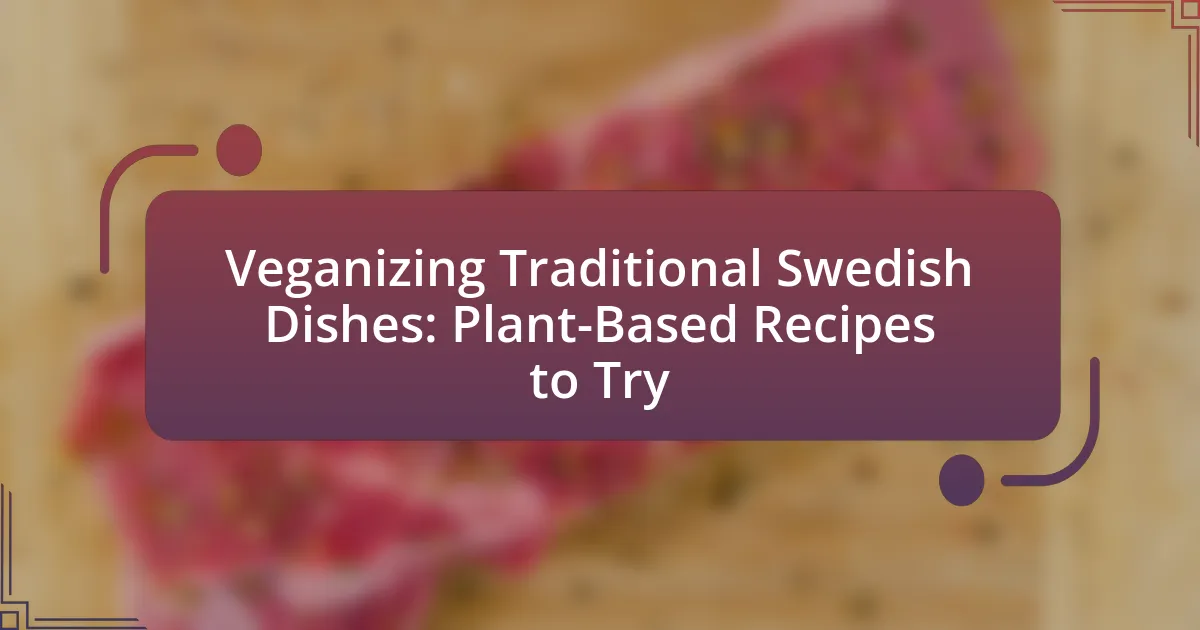Knäckebröd, a traditional Swedish crispbread, is characterized by its hard, dry texture and long shelf life, primarily made from rye flour, water, and salt. This article provides a comprehensive guide for beginners on making Knäckebröd, detailing its historical origins, cultural significance, and health benefits. It covers essential ingredients, preparation methods, variations, and popular toppings, along with tips for perfecting the baking process. Additionally, it offers insights into adapting traditional recipes for modern tastes and provides resources for finding Knäckebröd recipes.

What is Knäckebröd?
Knäckebröd is a traditional Swedish crispbread known for its hard, dry texture and long shelf life. This type of bread is typically made from rye flour, water, and salt, and is often baked until it becomes crisp. The origins of knäckebröd date back to the 19th century, where it was a staple in Swedish households due to its durability and ability to be stored for extended periods without spoiling.
How is Knäckebröd different from other types of bread?
Knäckebröd is different from other types of bread primarily due to its crisp texture and long shelf life. Unlike traditional bread, which is soft and moist, Knäckebröd is a dry, flatbread made from rye flour, water, and salt, often baked until it becomes crunchy. This unique preparation method results in a product that can last for months without spoiling, making it a staple in Swedish households. Additionally, Knäckebröd is typically enjoyed with various toppings, such as cheese or spreads, which contrasts with the more common use of soft bread for sandwiches.
What are the key ingredients in Knäckebröd?
The key ingredients in Knäckebröd are rye flour, water, salt, and sometimes yeast or baking soda. Rye flour serves as the primary base, providing the characteristic flavor and texture of the crispbread. Water is essential for forming the dough, while salt enhances the taste. Yeast or baking soda may be included to aid in leavening, although traditional recipes often omit these for a denser product.
Why is Knäckebröd considered a traditional Swedish food?
Knäckebröd is considered a traditional Swedish food because it has been a staple in Swedish cuisine for centuries, dating back to the 15th century. This crispbread is made primarily from rye flour, which is abundant in Sweden, and its long shelf life made it an essential food item for Swedish households, especially during long winters. The cultural significance of Knäckebröd is reinforced by its presence in Swedish celebrations and everyday meals, where it is often served with various toppings. Its historical roots and continued popularity in Sweden validate its status as a traditional food.
What are the historical origins of Knäckebröd?
Knäckebröd, or crispbread, originated in Sweden during the 19th century as a method to preserve bread for long periods. This type of bread was developed to withstand the harsh Scandinavian climate, allowing it to be stored for months without spoiling. The traditional preparation involved baking a thin dough made from rye flour, which contributed to its durability and unique texture. Historical records indicate that knäckebröd was commonly consumed by Swedish farmers and sailors, as it provided a reliable source of sustenance during long journeys and harsh winters.
How has Knäckebröd evolved over time?
Knäckebröd, or Swedish crispbread, has evolved from a traditional staple in Scandinavian diets to a versatile and globally recognized product. Initially, it was made from rye flour and water, baked hard to preserve it for long periods, which was essential for survival in harsh climates. Over time, variations emerged, incorporating different flours, seeds, and flavors, reflecting regional preferences and innovations. The introduction of modern baking techniques and ingredients has further diversified its forms, leading to the creation of gluten-free options and flavored varieties, making Knäckebröd appealing to a broader audience. This evolution is evidenced by its presence in international markets and its adaptation in various culinary contexts, showcasing its enduring popularity and versatility.
What cultural significance does Knäckebröd hold in Sweden?
Knäckebröd, or crispbread, holds significant cultural importance in Sweden as a traditional staple food that symbolizes Swedish culinary heritage. This flat, dry bread has been consumed in Sweden since the 16th century, reflecting the country’s agricultural practices and preservation methods. Historically, it was a practical solution for long winters, as its low moisture content allows for extended shelf life. Knäckebröd is often associated with Swedish meals, served alongside various toppings, and is a key element in festive occasions, showcasing its role in both daily life and celebrations. Its enduring presence in Swedish culture highlights the connection between food, tradition, and national identity.
What are the health benefits of Knäckebröd?
Knäckebröd, or Swedish crispbread, offers several health benefits, primarily due to its high fiber content and low calorie density. The fiber aids in digestion, promotes satiety, and can help regulate blood sugar levels. Additionally, knäckebröd is often made from whole grains, which provide essential nutrients such as B vitamins, iron, and magnesium. Studies indicate that whole grain consumption is linked to a reduced risk of heart disease and improved metabolic health. Furthermore, its low fat content makes it a suitable option for weight management.
How does Knäckebröd compare nutritionally to other breads?
Knäckebröd is generally lower in calories and higher in fiber compared to many other types of bread. For instance, a typical serving of Knäckebröd contains about 35-50 calories and 2-3 grams of fiber, while standard white bread can have around 70-80 calories and only 1 gram of fiber per slice. This higher fiber content in Knäckebröd contributes to better digestive health and can aid in weight management. Additionally, Knäckebröd is often made from whole grains, which provide essential nutrients and promote satiety, making it a healthier option compared to refined breads.
Why is Knäckebröd a popular choice for healthy eating?
Knäckebröd is a popular choice for healthy eating due to its high fiber content and low calorie count. This crispbread is typically made from whole grain rye, which provides essential nutrients and promotes digestive health. Studies indicate that whole grains can reduce the risk of chronic diseases, such as heart disease and diabetes, making Knäckebröd a nutritious option. Additionally, its versatility allows for various healthy toppings, enhancing its appeal as a balanced snack or meal component.

How do you make Knäckebröd?
To make Knäckebröd, combine whole wheat flour, rye flour, salt, and water to form a dough. Roll the dough out thinly, then cut it into desired shapes and prick with a fork to prevent bubbling. Bake the pieces in a preheated oven at 200°C (392°F) for about 10-15 minutes until they are crisp and lightly browned. This method is traditional in Sweden, where Knäckebröd has been a staple since the 19th century, providing a long-lasting bread option due to its low moisture content.
What are the basic steps in making Knäckebröd?
To make Knäckebröd, the basic steps include mixing flour, water, and salt to form a dough, rolling it out thinly, cutting it into desired shapes, and baking it until crisp. This process ensures the traditional texture and flavor of the Swedish crispbread. The dough typically consists of rye flour, which is essential for authentic Knäckebröd, and the baking temperature is usually around 200°C (392°F) for optimal crispness.
What equipment do you need to make Knäckebröd?
To make Knäckebröd, you need a mixing bowl, a rolling pin, a baking sheet, and an oven. The mixing bowl is essential for combining the ingredients, while the rolling pin is used to flatten the dough to the desired thickness. A baking sheet is necessary for placing the rolled dough before baking, and the oven is required to bake the crispbread until it is dry and crispy. These tools are fundamental in the traditional preparation of this Swedish crispbread, ensuring the correct texture and flavor.
How do you prepare the dough for Knäckebröd?
To prepare the dough for Knäckebröd, combine whole grain rye flour, water, salt, and a leavening agent such as baking powder or yeast in a mixing bowl. The mixture should be kneaded until it forms a smooth, pliable dough. This dough is typically rolled out thinly to achieve the characteristic crisp texture of Knäckebröd. The use of rye flour is essential, as it provides the traditional flavor and texture associated with this Swedish crispbread.
What variations of Knäckebröd can you try?
You can try several variations of Knäckebröd, including traditional rye, whole grain, and spiced versions. Traditional rye Knäckebröd is made primarily from rye flour, offering a dense texture and robust flavor. Whole grain variations incorporate a mix of flours, enhancing nutritional value while maintaining crispness. Spiced versions may include ingredients like caraway seeds or fennel, adding unique flavors to the classic recipe. These variations reflect the versatility of Knäckebröd, which has been a staple in Swedish cuisine for centuries, often enjoyed with various toppings.
How can you incorporate different flavors into Knäckebröd?
To incorporate different flavors into Knäckebröd, you can add various ingredients to the dough or toppings. For instance, mixing seeds such as sesame, poppy, or flaxseed into the dough enhances texture and flavor. Additionally, incorporating herbs like rosemary or thyme can provide aromatic qualities. Using spices such as cumin or coriander in the dough can also introduce unique tastes. Toppings like cheese, smoked salmon, or spreads such as hummus or avocado can further diversify the flavor profile. These methods are supported by traditional Swedish recipes that often include a variety of seeds and herbs to enhance the crispbread’s taste.
What are some popular toppings for Knäckebröd?
Popular toppings for Knäckebröd include butter, cheese, cured meats, and various spreads. Butter is often used as a base, providing a rich flavor that complements other toppings. Cheese varieties such as Västerbotten or cream cheese are commonly added for creaminess and taste. Cured meats like smoked salmon or ham enhance the savory profile, while spreads such as hummus or avocado offer a fresh twist. These toppings are traditional in Swedish cuisine, reflecting the versatility of Knäckebröd as a snack or meal component.
What common mistakes should you avoid when making Knäckebröd?
When making Knäckebröd, common mistakes to avoid include using incorrect flour types, not measuring ingredients accurately, and failing to properly knead the dough. Using all-purpose flour instead of rye flour can lead to a texture that is not characteristic of traditional Knäckebröd. Accurate measurements are crucial, as too much or too little water can affect the dough’s consistency and baking outcome. Additionally, insufficient kneading can result in a dense product rather than the desired crispness. These factors are essential for achieving the authentic flavor and texture of Knäckebröd.
How can you ensure your Knäckebröd turns out crispy?
To ensure your Knäckebröd turns out crispy, use a high oven temperature of around 250°C (482°F) during baking. This temperature allows for quick moisture evaporation, which is essential for achieving a crispy texture. Additionally, roll the dough thinly, ideally to about 2-3 mm, as thicker dough will retain moisture and result in a softer product. The use of a baking stone or preheated baking sheet can also enhance crispiness by providing even heat distribution.
What should you do if your Knäckebröd is too thick?
If your Knäckebröd is too thick, you should roll it out more thinly before baking. Rolling the dough to a thinner consistency ensures that the crispbread will bake evenly and achieve the desired crisp texture. A typical thickness for Knäckebröd is around 2-3 mm, which allows for proper cooking and crisping during the baking process.

Where can you find Knäckebröd recipes?
You can find Knäckebröd recipes in various online cooking websites, food blogs, and Swedish culinary books. Websites like Allrecipes, BBC Good Food, and traditional Swedish cooking blogs often feature authentic recipes. Additionally, cookbooks focused on Scandinavian cuisine typically include sections dedicated to Knäckebröd, providing detailed instructions and variations.
What are some classic Knäckebröd recipes for beginners?
Classic Knäckebröd recipes for beginners include the traditional rye crispbread and a simple oat crispbread. The traditional rye crispbread is made using rye flour, water, salt, and yeast, resulting in a dense and flavorful bread that can be baked until crisp. The oat crispbread, on the other hand, combines rolled oats, whole wheat flour, water, and a pinch of salt, creating a lighter texture that is also easy to prepare. Both recipes require minimal ingredients and straightforward preparation methods, making them ideal for those new to baking crispbread.
How can you adapt traditional recipes for modern tastes?
To adapt traditional recipes for modern tastes, one can incorporate healthier ingredients, adjust flavor profiles, and utilize contemporary cooking techniques. For example, in the case of knäckebröd, substituting refined flour with whole grain or gluten-free alternatives can enhance nutritional value while appealing to health-conscious consumers. Additionally, experimenting with spices and toppings, such as adding seeds or herbs, can modernize the flavor without losing the essence of the original recipe. Research indicates that consumers increasingly prefer recipes that align with dietary trends, such as plant-based or low-carb options, which supports the need for adaptation in traditional cooking.
What online resources are available for Knäckebröd recipes?
Online resources for Knäckebröd recipes include websites such as Allrecipes, BBC Good Food, and Swedish Food. These platforms offer a variety of recipes ranging from traditional to modern interpretations of the crispbread. Allrecipes features user-generated content with reviews and tips, while BBC Good Food provides professionally tested recipes with detailed instructions. Swedish Food specializes in authentic Swedish cuisine, offering insights into the cultural significance of Knäckebröd along with various preparation methods.
What tips can help you perfect your Knäckebröd making skills?
To perfect your Knäckebröd making skills, focus on using high-quality ingredients, particularly whole grain rye flour, which is essential for authentic flavor and texture. Additionally, ensure that you accurately measure your ingredients, as precise ratios contribute to the crispness and structure of the bread. Incorporating a proper hydration level in your dough, typically around 50-60%, is crucial for achieving the desired consistency.
Baking at the right temperature, usually between 200-220°C (392-428°F), allows for even cooking and optimal crispness. Finally, allow the Knäckebröd to cool completely on a wire rack after baking to maintain its crunchiness. These techniques are supported by traditional Swedish baking practices, which emphasize the importance of ingredient quality and precise methods for achieving the perfect crispbread.
How can you experiment with different flours in Knäckebröd recipes?
To experiment with different flours in Knäckebröd recipes, start by substituting traditional rye flour with alternatives like whole wheat, spelt, or gluten-free flours. Each type of flour will affect the texture and flavor; for instance, whole wheat flour adds nuttiness, while spelt flour can create a lighter crispbread. Adjust the liquid content accordingly, as different flours absorb moisture differently. Testing small batches allows for fine-tuning the ratios and achieving the desired crispness and taste. This method is supported by culinary practices that emphasize the importance of flour characteristics in baking, ensuring successful adaptations in recipes.
What are the best practices for storing Knäckebröd?
The best practices for storing Knäckebröd involve keeping it in a cool, dry place, ideally in an airtight container to maintain its crispness. This method prevents moisture absorption, which can lead to sogginess and spoilage. Additionally, storing Knäckebröd away from direct sunlight helps preserve its flavor and texture, as exposure to light can degrade the quality over time.




